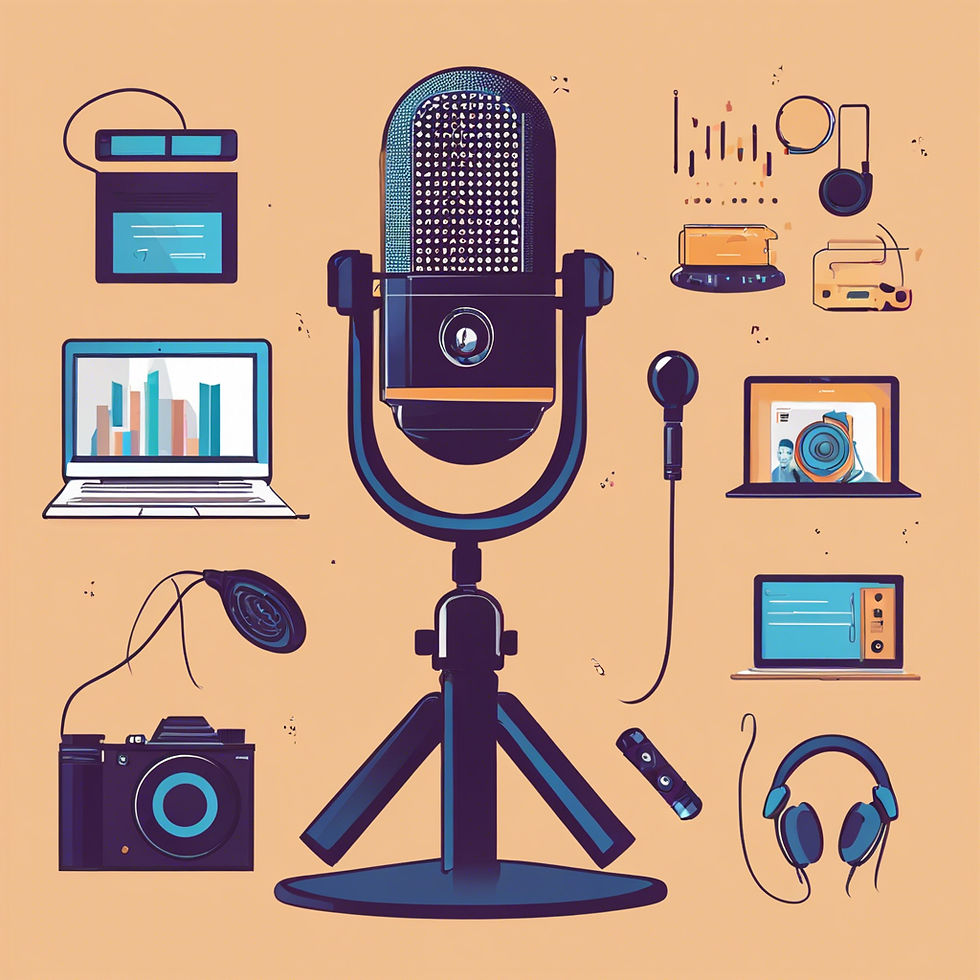Mastering the Art of Video Podcasting: A Step-by-Step Guide to Launching Your Show
- The Podcast Editor
- Sep 1, 2024
- 3 min read
Updated: Oct 8, 2024

Starting a video podcast can be an exciting way to engage with your audience visually as well as audibly. Here’s a step-by-step guide to help you get started:
1. Define Your Concept and Audience
Identify Your Niche: Choose a topic that you are passionate about and that will appeal to a specific audience.
Know Your Audience: Understand who your audience is and what they are interested in. This will help guide your content and format.
2. Plan Your Content
Outline Episodes: Plan out the first few episodes, including key topics, guests, and segments.
Structure: Decide on the structure of your show (e.g., interview format, solo commentary, panel discussions).
Show Branding: Develop a title, logo, and branding elements that represent your podcast.
3. Prepare Your Equipment
Camera: Invest in a good quality camera. A DSLR, mirrorless camera, or even a high-quality webcam can work.
Microphone: Audio quality is crucial, so use a good external microphone. USB microphones or XLR mics with an audio interface are popular choices.
Lighting: Use soft lighting to illuminate your face evenly and avoid shadows. Natural light or softbox lights are effective.
Backdrop: Choose a clean, visually appealing background or set up a dedicated studio space.
4. Set Up Recording and Editing Software
Recording Software: Use software like OBS Studio, Zoom, or Ecamm Live to record your video and audio.
Editing Software: Edit your podcast using video editing software such as Adobe Premiere Pro, Final Cut Pro, or DaVinci Resolve.
Audio Editing: Clean up your audio using software like Audacity or Adobe Audition.
Pro Tip: I can help you edit your audio and make you sound like a pro! Whether you're just starting or need to polish your episodes, feel free to reach out for professional audio editing assistance.
5. Create Your Content
Script and Outline: Prepare a script or outline for your episodes, especially for intros, outros, and key points.
Recording: Record your episodes, ensuring good audio and video quality. Practice speaking clearly and engagingly.
Editing: Edit your episodes to ensure a smooth flow, cut out mistakes, and add any necessary graphics, music, or effects.

6. Design Your Branding Elements
Thumbnail: Create eye-catching thumbnails for each episode. Tools like Canva can help.
Intro/Outro: Create or commission a short intro and outro video, including your logo and music.
Music: Choose background music that fits your podcast's tone. Make sure to use royalty-free music or obtain the necessary licenses.
7. Host and Distribute Your Podcast
Choose a Hosting Platform: Use a podcast hosting service that supports video, such as YouTube, Vimeo, or platforms like Anchor or Libsyn (for audio versions).
RSS Feed: If you plan to distribute an audio version, ensure your hosting platform provides an RSS feed to submit to directories like Apple Podcasts, Spotify, and Google Podcasts.
8. Promote Your Podcast
Social Media: Promote your episodes on social media platforms like Instagram, Twitter, and Facebook.
Website/Blog: Create a website or blog for your podcast where you can post episodes, show notes, and additional content.
Engage with Your Audience: Respond to comments, create interactive content, and encourage listeners to share your podcast.
9. Publish and Monitor
Schedule: Release episodes consistently, whether weekly, bi-weekly, or monthly.
Analytics: Track your podcast’s performance using analytics from your hosting platform or video site. This will help you understand what works and what needs improvement.
Feedback: Listen to your audience’s feedback and make adjustments to improve your content.
10. Monetize (Optional)
Sponsorships: Once your podcast gains traction, consider seeking sponsorships.
Ads: Use platforms that allow you to insert ads into your podcast.
Merchandise: Sell branded merchandise related to your podcast.
Starting a video podcast requires some initial setup and planning, but once you have a workflow in place, it can be a highly rewarding way to share your content and grow your audience.






Comments